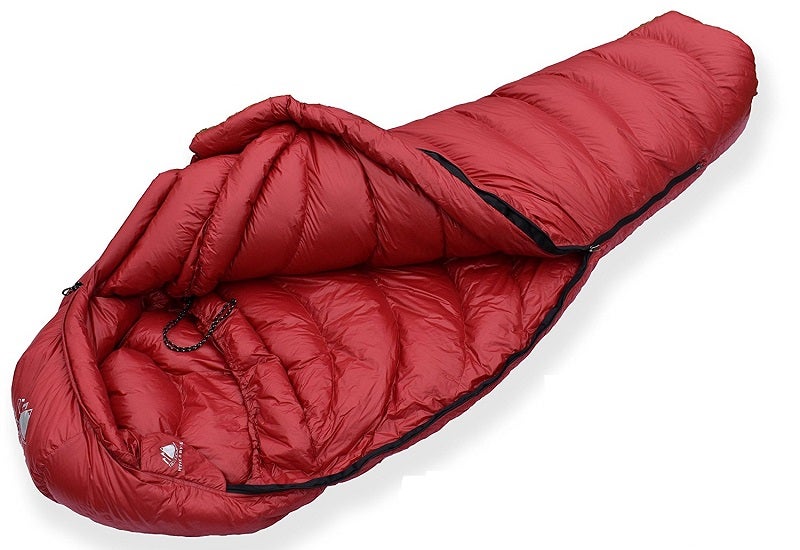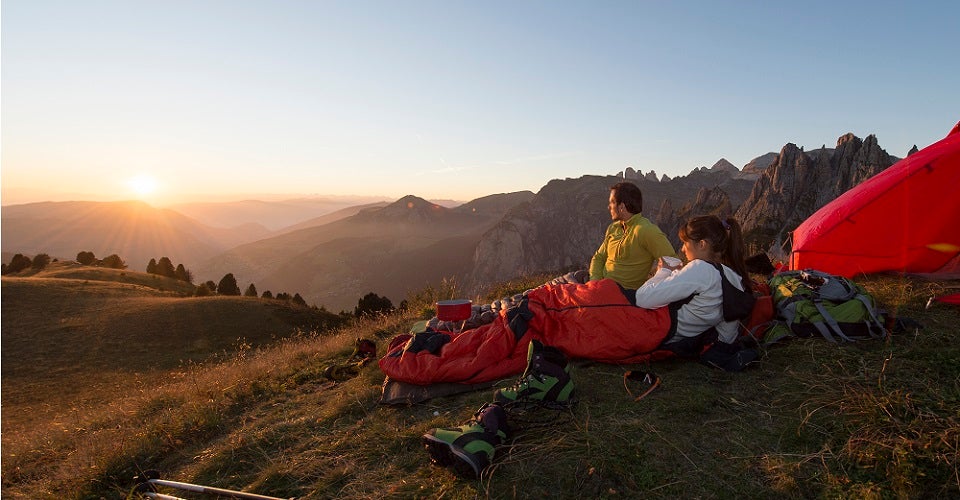
Our Editors independently research, test, and rate what we feel are the best products. We use affiliate links and may receive a small commission on purchases.
When you are looking for the best sleeping bag for backpacking it can be confusing for the beginner.
There are lots of details to consider.
As a longtime hiker and backcountry guide I’m going to help you sort through all the details. From what are the best brands, to should I get down or synthetic insulation.
It’s hard to be sure when everyone has a different opinion.
We’re going to learn about the different types of sleeping bags, what type of insulation is best, and what to watch for when buying a sleeping bag.
Best Backpacking Sleeping Bags
For more of my backpacking gear recommendations, have a look through these popular Outside Pursuits guide links: Backpacking Tents, Handheld GPS Units, Hiking Boots.
Quick Answer: The 7 Best Sleeping Bags For Backpacking
- Outdoor Vitals Down Ultra Light Sleeping Bag
- Teton Sport Tracker Lightweight Sleeping Bag
- Klymit Wild Aspen Sleeping Bag
- Sierra Designs DriDown Backcountry Bed
- Kelty Cosmic Down 20 Degree Sleeping Bag
- Hyke & Byke Snowmass 0 Degree Down Sleeping Bag
- Kelty Mistral Sleeping Bag
Our guide and comparison table of the top rated sleeping bags for backpacking will help you choose the right one for you.
Backpacking Sleeping Bag Reviews
#1 Outdoor Vitals Down Sleeping Bag
- 90% Down / 10% feather duck down
- Compresses down to 11 x 8 x 8 inches
- Weight including the compression bag is only 3 pounds
- Rated at 0°F
- Size: Regular Fits up to 6 Feet / Long Fits up to 6’6″
The Outdoor Vitals is one of my goto brands for ultralight backpacking sleeping bags. The bag is made from a high quality down and it is the lightest backpacking sleeping bag on our list.
Being made of a 90/10 (down to feather ratio) the bag compresses down to only 11 x 8 x 8 inches!
This bag will strap onto any backpack and weighing in at only 2.75 pounds, you will barely notice it. The durable shell is made from Outdoor Vitals “Rip-stop” Polyester that repels moisture and retains its shape.
Once you get in the bag you feel like you are in your own world of warmth. With its 800+ fill power down rating, the lower limit of 0 degrees is spot on and with a sleeping pad is comfortable at even lower temperatures.
Even though is doesn’t have a specific draft collar, it does and excellent job of trapping your body heat and keeping the cold air out. In my opinion this is one of the best sleeping bags for cold weather.
The zippers are a snag free high quality design that will give you years of trouble free use.
One thing to keep in mind with this bag, is being made of down, its important to not store it compressed, use the hooks to hang it and let it air out.
This Outdoor Vitals bag is a great bargain for the price, you will not find a similar quality down sleeping bag even close to its price range. I think it’s overall the best backpacking sleeping bag and perfect for cold sleepers.
#2 Teton Sport Tracker Ultralight Sleeping Bag
- Unpacked Size: 87” x 34” x 22”
- Weighs 4.1 pounds
- Packed size 15” x 9” x 9”
- Brushed micro polyester lining
- Shell: 75D diamond ripstop
- Interior pocket zips for electronics or wallets
- Innovative Pollarlite insulation
Teton Sport Tracker is a mummy bag that will guarantee you warmth on cold nights. It has Teton’s proprietary “Polarlite” insulation that will keep you warm while being lightweight as well.
The three piece hood will keep your face and ears fully covered as you sleep.
Having a zipper pulls accessible from inside and outside and running from the both the top and bottom, gives you the ability to zip up even if your hood is tied.
The bag is equipped with zippers that are taped with an anti-snag design made from Acetal Resin, it is also able to withstand extreme temperature conditions. The interior is made from a micropolyester liner that is so comfortable you won’t want to get out of it.
One of the nice features is a interior pocket that zips up keeping your phone, wallet or other valuables safe and dry.
The shell fabric is a made from a patented “ripstop” shell that is extremely tear and water resistant that can handle the abuse it will likely see on the trail.
The Teton Sports Tracker weighs in at only 4.1 pounds, so it’s a lightweight backpacking sleeping bag.
Teton Sports has a reputation for making durable and quality products and the Sports Tracker will not disappoint.
In my opinion, the Teton Sports is the best backpacking sleeping bag under $100. If your looking for a cheap backpacking sleeping bag, you won’t go wrong with the Teton Sports Tracker.
#3 Klymit Wild Aspen Sleeping Bag
- Synthetic Filling
- Weight: 2.5 pounds
- Packed size: 15″ x 8″
- Unpacked size: 74” x 30”
- Temperature rating: 20 Fahrenheit
The Klymit Wild Aspen is a lightweight backpacking sleeping bag suitable for 3 seasons. Its lower limit is rated for +20 degrees F and a comfort rating of +25, however you could still be warm at 15F with a good sleeping pad.
This lightweight sleeping bag weighs in at 2.5 pounds including the compression sack and measures 15″x8″ when compressed so it takes up little room in your backpack.
Probably my favorite feature, other than its warmth, are the fully adjustable deep pocket hood and zipper draft tube that keep you cozy when you need it.
Uncompressed it measures 74 x 30 inches with extra room at the foot of the bag keeping your feet comfortable.
The Klymit Wild Aspen sleeping bag is a quality backpacking mummy bag for a mid range price.
#4 Sierra Designs Backcountry Bed Sleeping Bag
- 700 Fill Power FCF DriDown
- Shell: N/A
- Unpacked Size: N/A
- Weighs 2 pounds, 8 ounces
- Packed size: 10″ x 15″
There has not been a lot of innovation in sleeping bags over the years. The Sierra designs is the first sleeping bag to break the mold with a unique design.
This backpacking sleeping bag has no zippers of any kind, instead there is a relatively large “U” opening that you crawl into. Then you fold the down flap over top of you.
This unique design makes the bag very comfortable and allows you to regulate your temperature pretty easily.
This is a 3 season bag is rated to roughly 35 degrees but could be used in temperatures down to 20 degrees without any noticeable cold spots. Maybe even lower with a good sleeping pad.
The Sierra Designs puts 24 oz of duck down that is treated with a molecular polymer that Sierra Designs calls “DriDown” and helps the down keep its “loft” and stay dry longer than non-treated down.
Video: Overview of the Sierra Designs Backcountry Bed.
This is not the lightest sleeping bag by any means, it weighs in at around 2 pounds mostly due to the extra down insulation. The lack of zippers shaves a bit of weight off it but the thicker, tougher polyester ripstop adds back any weight savings.
The bag being down, is of course compressible and includes a stuff sack but it only compresses down to 8.5″ x 16”. A bit on the larger size but certainly not too big for backpacking.
The name is appropriate “Backcountry Bed”, with the extra down it is by far one of the most comfortable sleeping bags I have ever slept in. It’s almost like taking the bed at your house and transporting it into the wilderness.
With the unique design, you have significantly more room to move your upper body around and the down flap allows unmatched temperature regulation. If you’re a stomach sleeper, this is the sleeping bag for you!
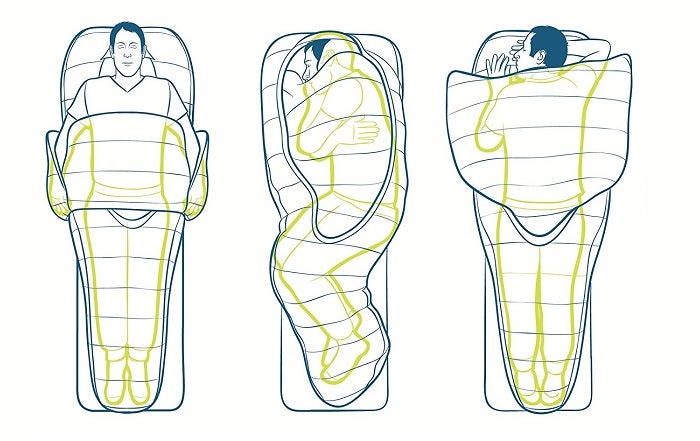
If you are used to the mummy bag this bag will be an eye opener with the extra room. The Sierra Designs Backcountry Bed is pretty versatile in that it’s a good backpacking sleeping bag for short to intermediate hikes and car camping.
You have significantly more versatility in how you use the bag with its comforter flap design that does an excellent job of trapping your body heat.
I wouldn’t want to take it for extended hikes with the extra weight, unless the extra comfort is worth the extra pound over an ultra light sleeping bag.
If you are camping in below freezing temperatures the Sierra Designs offers the advantage of you can wear a fleece or other layers for extra warmth.
The Backcountry offers a unique design, exceptional comfort and warmth at a mid-range price. It comes in a regular and long size for those over 6 feet. While the Sierra Designs might not be the best 3 season bag on the market, it may be the most comfortable!
#5 Kelty Cosmic Down Sleeping Bag
- 550 Fill Dridown
- Shell: 50D Polyester Ripstop shell
- Size: Regular Fits up to 6 Feet / Long Fits up to 6’6″
- Weighs 2 pounds, 13 oz
- Packed size: 8 x 14 inches
If you are looking for a budget priced backpacking sleeping bag, the Kelty Cosmic Down is a solid contender. The Kelty isn’t the best in any area like weight, warmth and size but it does everything reasonably well.
The Kelty Cosmic is a 3 season bag and is rated at 600 fill power for a lower limit rating of 20 degrees. I don’t think it is as warm as some of the more expensive 20 degree bags however.
It has 21 oz of “DriDown” insulation that is treated with a molecular polymer to better keep its loft, dry faster and keep its warmth over time.
If your going to be camping in temperatures under 30 degrees I would recommend a sleeping pad or wearing extra layers to stay warm.
The bag is roomy enough to allow you to wear layers and the thermal-comfort hood does a good job keeping your upper body warm.
Video: Overview of the Kelty Cosmic 20.
The Kelty Cosmic tips the scales at 2.75 pounds which makes it one of the lightest of the the ultra-light sleeping bags and considering its warmth and price its a great deal. It’s appropriate for most any backpacking trip length and of course car camping.
For the price you have to give up something and with the Kelty the shell material is not a “rip stop” fabric so it’s not as tough and durable as other bags. As long as you don’t abuse it and take care of the bag it will last a long time.
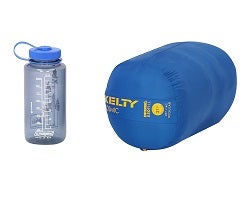
The Kelty Cosmic is spacious as it slighter wider than comparable sleeping bags and as a result offers a comfortable nights sleep.
If you don’t like the traditional “mummy” style because its lack of room, you will definitely appreciate the extra width of the Cosmic 20.
I have always found down to be more comfortable than synthetic sleeping bags and the Kelty is no exception.
Being a budget sleeping bag it offers excellent value and compresses down to 8 x 14 inches with the included compression sack. It comes in a regular and long size for those over 6 feet.
The Kelty Cosmic 20 is one the best backpacking sleeping bags under $200 on the market.
#6 Hyke & Byke Snowmass Down Sleeping Bag
- 90/10 550 Premium quality duck down
- Shell: 400T 20 D Ripstop Nylon
- Size Regular Fits up to 6.1 Feet / Long Fits up to 6’6″
- Weighs 4 pounds
- Packed size: 11 x 8 inches
Hyke & Byke is a newcomer in the backpacking community and are making an impression with the Snowmass 0 Degree Sleeping Bag.
I was impressed with the 1200g of duck down fill with a 90/10 ratio of down to fill and 550 fill power. This is what makes this bag perfect for cold sleepers and is rated for 0 degrees F.
Since it wasn’t that cold when I used it, I can’t say if it will keep you warm at 0F but at 30F it was warm enough where I needed to unzip it in the middle of the night.
I like the founder’s attitude, he is a fan of Henry David Thoreau and donates 10% of their profit to Kiva. They provide microloans in 3rd world countries for entrepreneurs to improve their lives and of their families.
Now that’s not why you want to buy a Hyke and Byke mummy style sleeping bag, you buy it because its one of the best 0 degree sleeping bags for backpacking on the market. Even though it lacks a draft collar, it wraps around your face keeping out the cold.
The Snowmass comes in two sizes, the regular is good for someone up to 6’1” and the long for up to 6’6” and weighs just under 4 pounds. Certainly not the lightest bag there is but its all of that duck insulation.
The shell fabric of the bag is very lightweight 400T 20D ripstop nylon that is water repellent and extremely tough and durable. The bag is one of the more comfortable I have used, with the extra down providing cushioning there are no cold spots even if you’re not using a sleeping pad.
Even if you’re a big guy, you should have plenty of room, the long size is 64” wide at the shoulder and the regular is 59” wide. The Hyke and Byke Snowmass compresses down to 11” x 8” with the stuff sack.
There is a lot to like about the Snowmass, I think its one of the best lightweight sleeping bags you can buy.
#7 Kelty Mistral Synthetic Camping Sleeping Bag
- Cloudloft Insulation
- Shell: 190T Teffeta Polyester
- Size: Regular Fits up to 6 Feet / Long Fits up to 6’6″
- Weighs 3 lbs 5 oz
- Packed size: 10 x 17 inches (non-compressed)
This is my second Kelty Tuck recommendation and in contrast to the Cosmic, this one uses Kelty’s “Cloudloft” insulation which is a synthetic blend.
I am not a huge fan of synthetic insulation, I prefer duck down. With that said the Cloudloft insulation is rated down to 20 degrees. I wouldn’t push it that far without a good sleeping pad underneath you though.
This 3 season sleeping bag is one of the lighter ones on the market coming in at 3 pounds and 3 ounces and packs down to 17” high by 10” wide before it’s compressed. It comes in two sizes, the regular for 6 feet and under and the long for up to 6’ 6”, as well as a handful of different temperature ratings and colors.
It has some features that you would only expect to see on more expensive sleeping bags, like a comfort hood and an anti-snag zipper.
Kelty has an excellent reputation for making quality, durable backpacking equipment and the Mistral sleeping bag continues that tradition. A strong contender for the best budget backpacking sleeping bag!
Backpacking Sleeping Bag Comparison Table
| Backpacking Sleeping Bag | Fill | Shell | Weight | Temp Rating | Rating | |
|---|---|---|---|---|---|---|
| Outdoor Vitals Down Sleeping Bag | 90% Down / 10% duck down | 20D Ripstop Nylon | 2.1 pounds | 0° F | 4.5 / 5.0 | |
| Teton Sport Tracker Ultralight Sleeping Bag | Synthetic Pollarlite insulation | 75D diamond ripstop | 4.1 pounds | +5 F | 4.4 / 5.0 | |
| Klymit Wild Aspen 3 Season Down Sleeping Bag | Synthetic | Polyester | 2.5 pounds | +20 F | 4.2 / 5.0 | |
| Sierra Designs Backcountry Bed | 700 Fill DriDown | N/A | 2.3 pounds | +20-35 F | 5.0 / 5.0 | |
| Kelty Cosmic Down Sleeping Bag | 550 Fill Dridown | 50D Polyester Ripstop shell | 2.75 pounds | +20 F | 4.5 / 5.0 | |
| Hyke & Byke Snowmass Down Sleeping Bag | 90/10 550 duck down | 400T 20 D Ripstop Nylon | 4 pounds | 0° F | 4.6 / 5.0 | |
| Kelty Mistral Synthetic Camping Sleeping Bag | Cloudloft Insulation | 190T Polyester Taffeta | 3 pounds | +20 F | 4.5 / 5.0 |
How to Choose a Good Sleeping Bag For Backpacking
- Selecting the Right Type of Sleeping Bag
- Types of Insulation
- Evaluating a Sleeping Bag
- Care For Your Sleeping Bag
- Best Sleeping Bag Brands
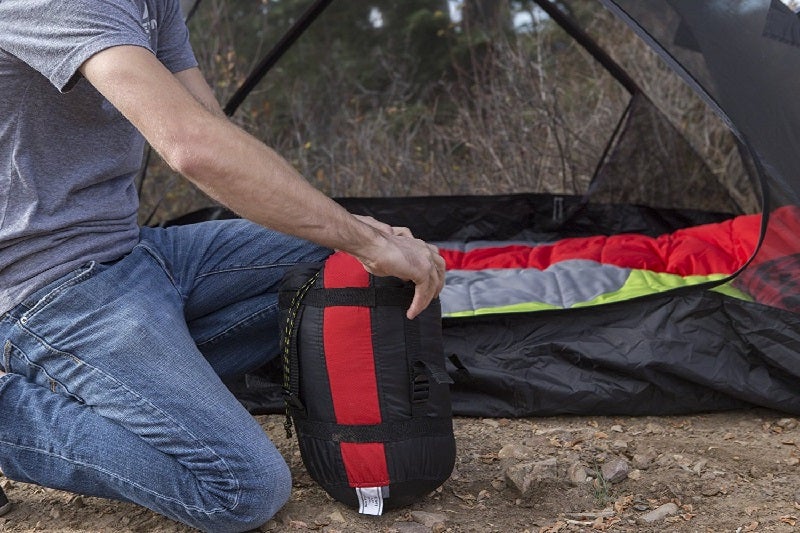
Choosing the right sleeping bag might the most important decision of your backpacking trip. There are a lot of decisions you will need to make to choose the right sleeping bag.
Your biggest decision you will need to make is the choice of down or synthetic insulation. They each of course have their advantages and disadvantages.
Above we tried to give you a summary of all the different types of bags to help you make an informed decision. This review has its focus geared on hiking sleeping bags but are suitable for car camping as well.
All of our reviewed bags are unisex, there are no specific women’s models reviewed. If you set on one however, I would recommend the Marmot Trestles Mummy Sleeping Bag.
Type Of Sleeping Bag: Which is Right for You?
What type of sleeping bag will suit your needs? As much as outdoor sleeping should be fun, it doesn’t need to be expensive.
The best sleeping bag should be budget friendly, lightweight and pack up to small size so it doesn’t take up too much room in your pack. The following are the types of sleeping bags that will commonly find.
Backpacking Sleeping Bag
If you are the person who wants a lightweight sleeping bag that is suitable for 3 season camping and light enough to pack into the backcountry, this is the bag for you. They are lightweight but are still comfortable for most backpackers to be comfortable.
Camping Sleeping Bags
Camping Sleeping Bags are usually too heavy for a backpack but also tend to be the thickest and most comfortable. If your not hiking to far to your campsite you may be able to use one. They are also usually cheap and can be had for less than $50, sometimes even cheaper.
Ultralight Sleeping Bags
If your backpacking trip will be more than overnight and involve hiking any sort of distance then this type of sleeping bag is what you will need to invest in.
The ultralites are usually under 3 pounds and made of down because of its lightweight and warmth. The Outdoor Vitals is a great example of an ultralight sleeping bag.
Types of Insulation
The insulation type of the sleeping bag is your most important consideration. There are two mains types, down and synthetic. Your budget, packing requirements and the season your camping in will determine which type will be best for your needs.
Down
If durability, warmth and compressibility are your primary concerns, then down should be your sleeping bag of choice. They have many pros over their synthetic counterparts and typically lower European or EN ratings or fill power down ratings.
Five of our recommended sleeping bags are down for this reason. No synthetic insulation has yet to match the warmth to weight ratio of down from our feathered friends. Most 4 season bags are made from down for this reason.
Synthetic
Synthetic sleeping bags are best known for their ability to withstand wet conditions and better at keeping their shape and insulating properties in those type of conditions.
However, they are bulkier and heavier than down sleeping bags so you will need to keep this in mind. They are also cheaper, so if your budget doesn’t allow for a down bag then you will need to go the synthetic route. Most synthetic insulated sleeping bags are rated 3 season bags.
What to Look For in a Backpacking Sleeping Bag
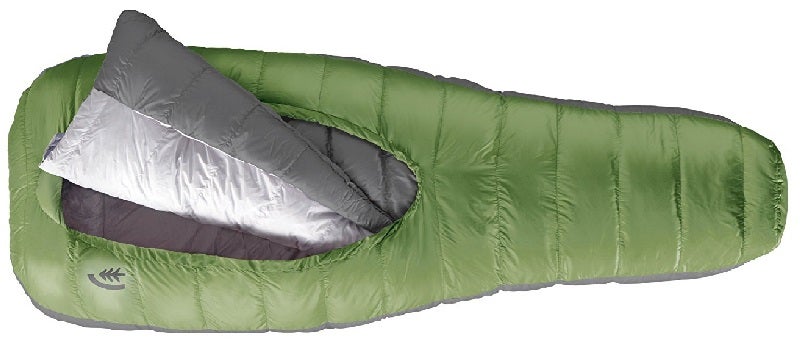
We evaluated the sleeping bags the basis of their weight, warmth, packed size, features & accessories and versatility.
Warmth
The thickness of the sleeping is going to determine its ability to keep you warm. Its simple physics, a thicker bag allows more space between you and the cold air and ground.
A tighter fitting, mummy style bag will keep you the warmest as it will not allow for cold air to get in between you and the sleeping bag.
As stated above, down sleeping bags tend to be thicker when uncompressed and therefore will keep you warmer than a synthetic bag. We found the Outdoor Vitals to be the thickest and warmest of the sleeping bags.
The Teton Tracker was the least warm and no coincidence had synthetic insulation.
Temperature Rating
Most sleeping bags will have a European or EN rating for how low of temperature the sleeping bag is comfortable for the average women or man. Unfortunately this rating is not the end all, be all.
You can use it as a general guide for comparison but two sleeping bags with the same rating can be wildly different in how warm you feel they are. Most sleeping bags are “3 season”, meaning for spring, summer and fall and have a rating between 15 and 40 degrees F.
One thing that will make a big difference in how warm you are is using a sleeping pad. Using a pad in cold conditions or if your really hard core and sleeping on the snow then its a necessity not a luxury.
Weight
A sleeping bag will either be your heaviest packed item or close to it. When backpacking lighter is always better so you will need to consider weight and comfort vs warmth.
If your camping in cold weather you’re not going to have much choice but to go with a heavier warmer bag.
Packed Size
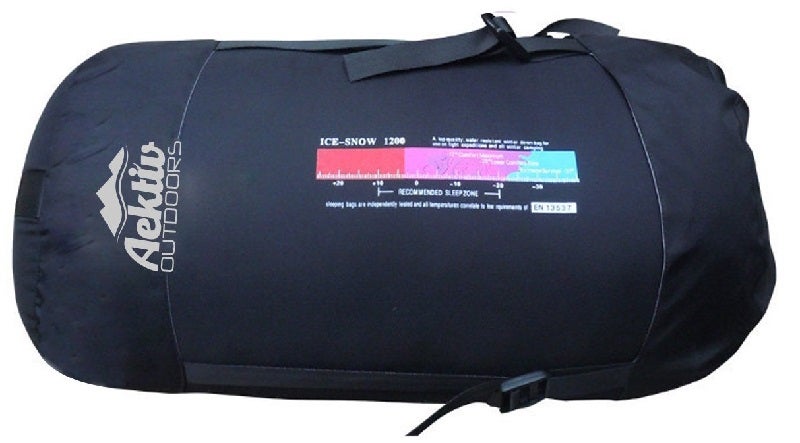
When you want the smallest possible size of packed sleeping bag then there really is no comparison with a down sleeping bag. Synthetic bags just cannot compress any where near as small and tight as down.
The Aektiv Outdoor was able to compress to the smallest size of any bag we tested. Some specific women’s models can be lighter and smaller but not by enough to make a big difference.
Water Resistance
By its nature, synthetic insulation resists water better than down and does a better job of keeping you warm when it’s wet. Some of the newer treated down sleeping bags come close to synthetic in this regard now but it doesn’t come cheap.
Your best bet is prevention, if you think you may encounter rain; keep a waterproof cover over your sleeping bag.
Shell
The latest innovation in the shell fabric of sleeping bags is DWR or Durable Water Repellant. This treatment of the shell causes water to bead up and roll of the bag, just like wax on your car.
Its not 100% effective but it does make a difference, its worth looking for a bag with this treatment.
Zipper
Not all sleeping bags have a full length zipper to completely unzip the bag. This is a nice feature, so you can fully open the bag for warm weather.
Some of the ultra-light weight sleeping bags forgo the full length zipper to save some weight, with this design your feet will be tucked in all the time.
Versatility
The sleeping bag that will allow you to use in cold and wet conditions will of course be the most versatile. So you should consider where you will be camping and the time of year you will using it before making a decision.
If you are a year round camper or not sure when you will be going, then you need to go with the most versatile sleeping bag that fits your budget. We found the Outdoor Vitals to be the most versatile sleeping bag and warm enough for the average woman or man.
Comfort
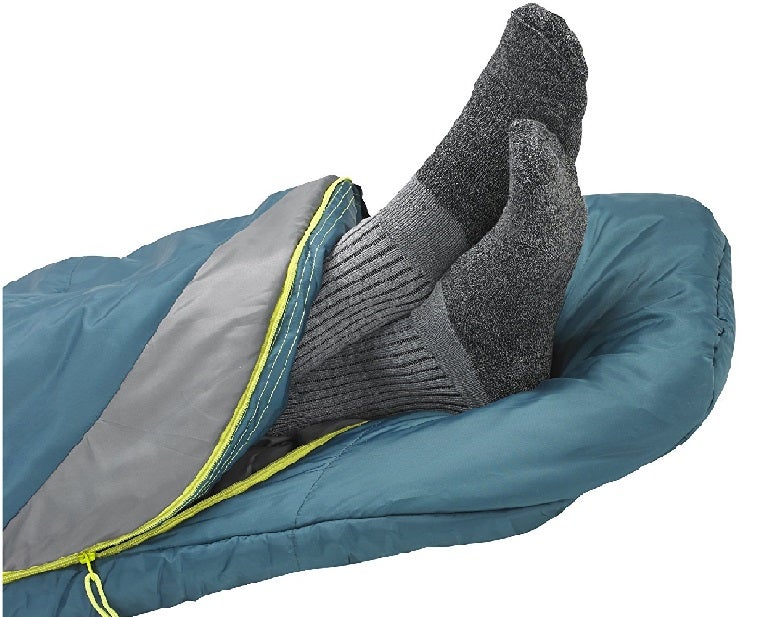
Comfort goes hand in hand with the size and thickness of the bag. A bigger, roomier bag will leave more space for movement within it.
However, the downside is that in colder weather that extra space will allow for cold air to come between you and the sleeping bag keeping you colder than tighter fitting bag.
So there is a bit of a trade off there. The longer your trip is then you will need to take this into consideration more so than a simple overnight trip. We found the Aektiv Outdoor bag to be the most comfortable.
Cost
A quality sleeping bag is not going to be “cheap” and most likely one of your most expensive purchases. It is also one of the most critical. This is not an item to scrimp on, you will be best served buying the best bag you can afford.
That doesn’t mean you need to spend a fortune, for less than $200 you can good a good sleeping bag.
Features and Accessories
Most sleeping bags come with standard features like heavy duty zippers, a durable shell, draft tubes and a stash pocket. The features you should focus on are those that increase warmth, comfort or convenience.
One nice extra feature we found useful was a water resistant stash pocket for keeping your phone or GPS device in.
How to Care For Your Backpacking Sleeping Bag
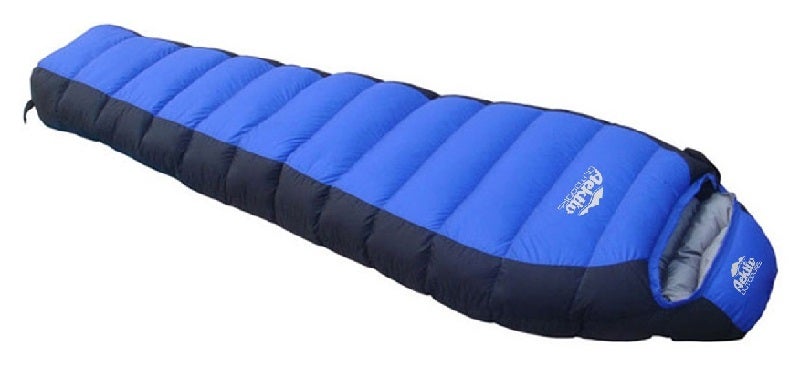 If you want long service from your sleeping bag, just like with a down jacket, you need take care of them, no big secret there. A sleeping bag with down is more work to take care of. Your main consideration with a down sleeping bag is not to store it in it’s stuff sack but store it hanging vertically.
If you want long service from your sleeping bag, just like with a down jacket, you need take care of them, no big secret there. A sleeping bag with down is more work to take care of. Your main consideration with a down sleeping bag is not to store it in it’s stuff sack but store it hanging vertically.
So when you get home from your trip, the first thing you should do is to take it out of the compression sack and unfold it.
Down Sleeping Bags
Typically come with hooks at the bottom to store them hanging so they can maintain their thickness and keep them aired out. Make sure when you clean your down sleeping bag to use a mild soap recommended by the manufacturer.
Synthetic Sleeping Bags
On the other hand are way easier to deal with than down that comes from our feathered friends. They can be put in the washing machine as water does not damage them or clump up the insulation.
A synthetic sleeping bag in general will not last as long as a quality down sleeping bag that is properly cared for. But that is somewhat balanced out in that they are typically cheaper.
If you can afford paying a little more you will be better served buying a quality sleeping bag like the Aektiv Elements or Outdoor Vitals.
Best Sleeping Bag Brands
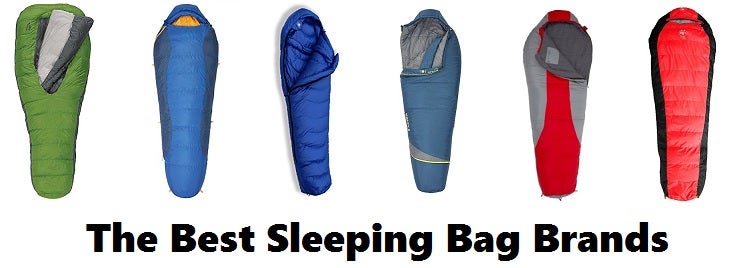 There are quite a few manufactures of quality sleeping bags, I will list a few of my favorite ones here:
There are quite a few manufactures of quality sleeping bags, I will list a few of my favorite ones here:
- Sierra Designs – Founded in Boulder Co in 1965, they make a wide range of backpacking and camping gear available from Amazon and REI co-op.
- TETON Sports – Focus on making quality camping gear at inexpensive prices.
- Kelty – Dedicated to not only producing a fine line of down jackets and sleeping bags but also protecting the environment.
- Hyke & Byke – As the name suggests, they make biking and hiking gear but they also donate 10% of their profit to Kiva. Available from Amazon and REI co-op.
- Marmot – Founded in Colorado by local resident Tom Boyce in 1974, they make some very high end outdoor gear.
- Western Mountaineering – Founded over 30 years ago and focus solely on making high end sleeping bags and winter garmets.
I hope this guide was helpful for finding a good backpacking sleeping bag to fit your needs. If you want to comment or recommend a sleeping bag I didn’t include, please use my contact form to get in touch.
Have fun and be safe out there!

